BMP4104: HRM Report on Performance Improvement at Winchester Homes
VerifiedAdded on 2023/05/30
|12
|2738
|470
Report
AI Summary
This report addresses human resource management issues at Winchester Homes, focusing on the importance of effective people management in improving organizational performance and staff wellbeing. It evaluates factors affecting staff performance, such as ineffective appraisal systems, inadequate training, low salaries, lack of motivation, and poor workplace health and safety measures. The report recommends suitable development techniques, including individual development plans, regular performance appraisals, mixed training methods, interactive sessions, and task rotations. Specific actions to improve staff wellbeing and performance include adopting a suitable remuneration system, acknowledging and rewarding employees, using a participative leadership style, and improving workplace health and safety. The report concludes that addressing these issues through improved HRM practices requires collaboration between management and staff.
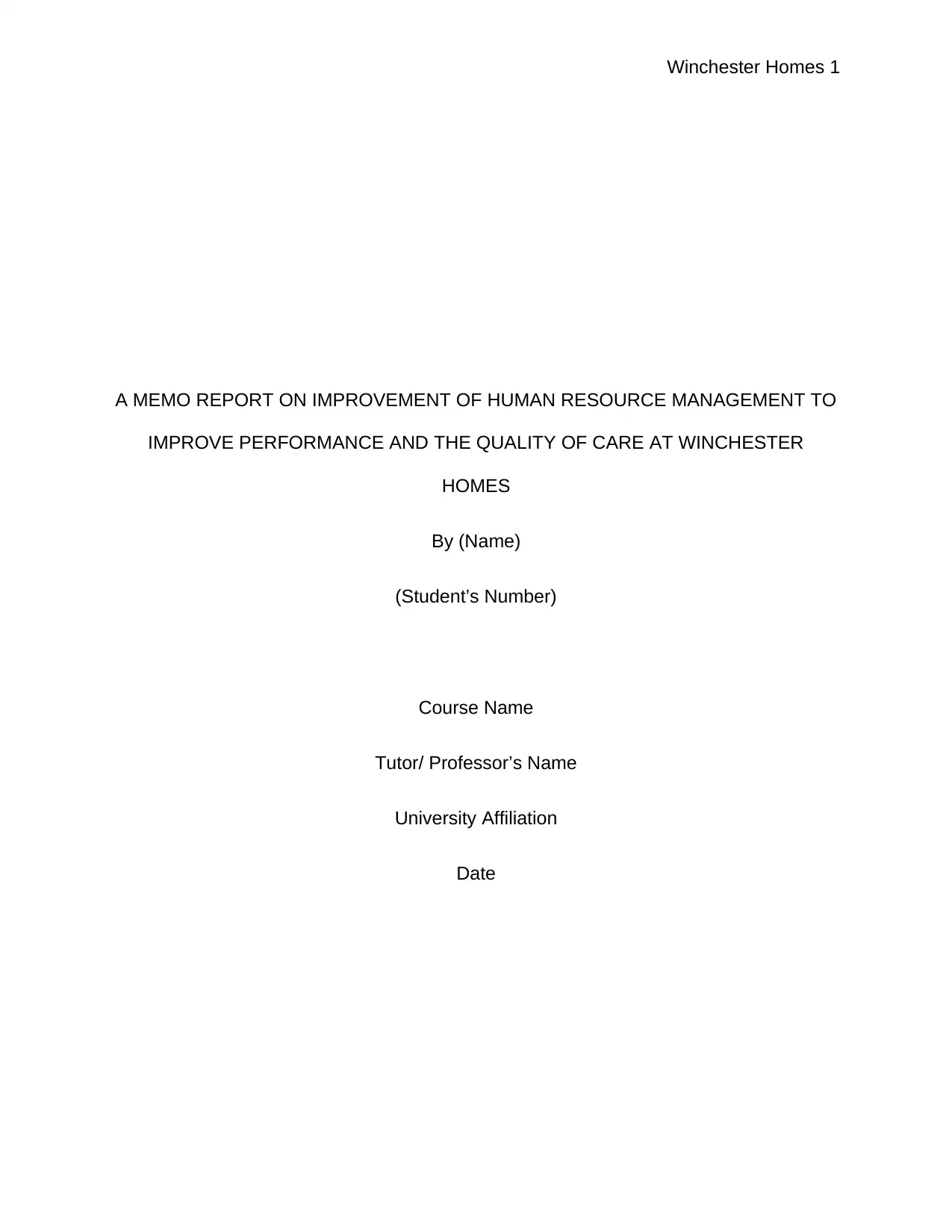
Winchester Homes 1
A MEMO REPORT ON IMPROVEMENT OF HUMAN RESOURCE MANAGEMENT TO
IMPROVE PERFORMANCE AND THE QUALITY OF CARE AT WINCHESTER
HOMES
By (Name)
(Student’s Number)
Course Name
Tutor/ Professor’s Name
University Affiliation
Date
A MEMO REPORT ON IMPROVEMENT OF HUMAN RESOURCE MANAGEMENT TO
IMPROVE PERFORMANCE AND THE QUALITY OF CARE AT WINCHESTER
HOMES
By (Name)
(Student’s Number)
Course Name
Tutor/ Professor’s Name
University Affiliation
Date
Paraphrase This Document
Need a fresh take? Get an instant paraphrase of this document with our AI Paraphraser
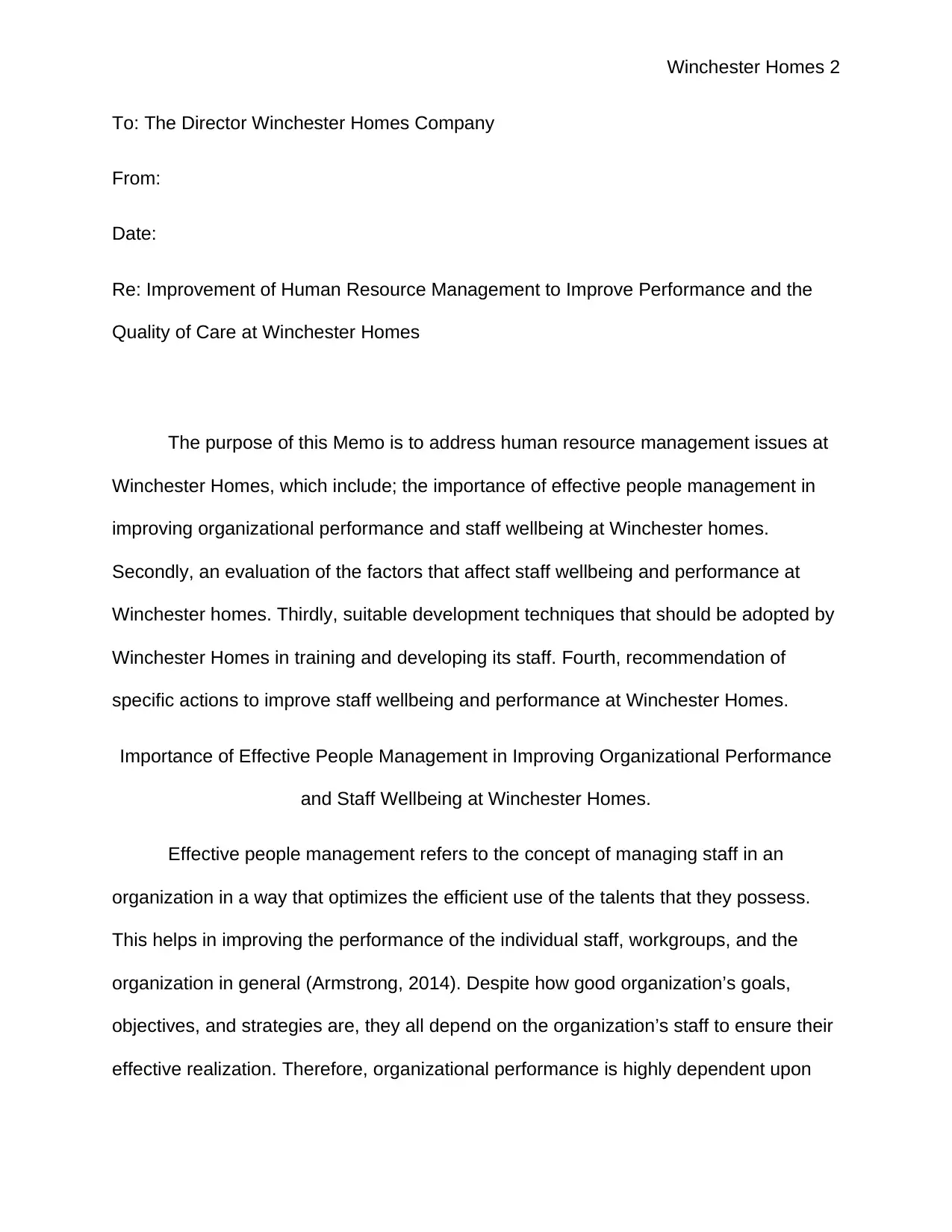
Winchester Homes 2
To: The Director Winchester Homes Company
From:
Date:
Re: Improvement of Human Resource Management to Improve Performance and the
Quality of Care at Winchester Homes
The purpose of this Memo is to address human resource management issues at
Winchester Homes, which include; the importance of effective people management in
improving organizational performance and staff wellbeing at Winchester homes.
Secondly, an evaluation of the factors that affect staff wellbeing and performance at
Winchester homes. Thirdly, suitable development techniques that should be adopted by
Winchester Homes in training and developing its staff. Fourth, recommendation of
specific actions to improve staff wellbeing and performance at Winchester Homes.
Importance of Effective People Management in Improving Organizational Performance
and Staff Wellbeing at Winchester Homes.
Effective people management refers to the concept of managing staff in an
organization in a way that optimizes the efficient use of the talents that they possess.
This helps in improving the performance of the individual staff, workgroups, and the
organization in general (Armstrong, 2014). Despite how good organization’s goals,
objectives, and strategies are, they all depend on the organization’s staff to ensure their
effective realization. Therefore, organizational performance is highly dependent upon
To: The Director Winchester Homes Company
From:
Date:
Re: Improvement of Human Resource Management to Improve Performance and the
Quality of Care at Winchester Homes
The purpose of this Memo is to address human resource management issues at
Winchester Homes, which include; the importance of effective people management in
improving organizational performance and staff wellbeing at Winchester homes.
Secondly, an evaluation of the factors that affect staff wellbeing and performance at
Winchester homes. Thirdly, suitable development techniques that should be adopted by
Winchester Homes in training and developing its staff. Fourth, recommendation of
specific actions to improve staff wellbeing and performance at Winchester Homes.
Importance of Effective People Management in Improving Organizational Performance
and Staff Wellbeing at Winchester Homes.
Effective people management refers to the concept of managing staff in an
organization in a way that optimizes the efficient use of the talents that they possess.
This helps in improving the performance of the individual staff, workgroups, and the
organization in general (Armstrong, 2014). Despite how good organization’s goals,
objectives, and strategies are, they all depend on the organization’s staff to ensure their
effective realization. Therefore, organizational performance is highly dependent upon
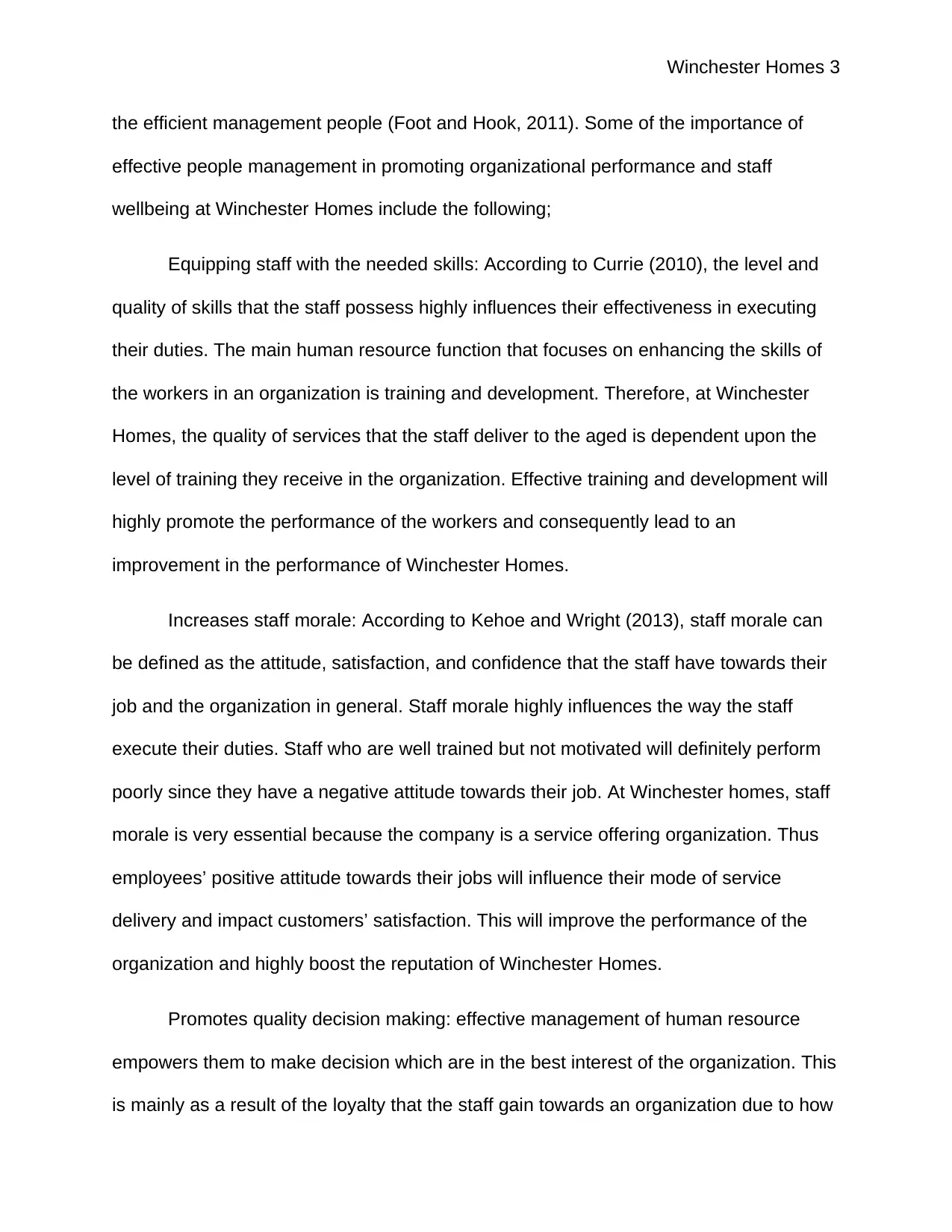
Winchester Homes 3
the efficient management people (Foot and Hook, 2011). Some of the importance of
effective people management in promoting organizational performance and staff
wellbeing at Winchester Homes include the following;
Equipping staff with the needed skills: According to Currie (2010), the level and
quality of skills that the staff possess highly influences their effectiveness in executing
their duties. The main human resource function that focuses on enhancing the skills of
the workers in an organization is training and development. Therefore, at Winchester
Homes, the quality of services that the staff deliver to the aged is dependent upon the
level of training they receive in the organization. Effective training and development will
highly promote the performance of the workers and consequently lead to an
improvement in the performance of Winchester Homes.
Increases staff morale: According to Kehoe and Wright (2013), staff morale can
be defined as the attitude, satisfaction, and confidence that the staff have towards their
job and the organization in general. Staff morale highly influences the way the staff
execute their duties. Staff who are well trained but not motivated will definitely perform
poorly since they have a negative attitude towards their job. At Winchester homes, staff
morale is very essential because the company is a service offering organization. Thus
employees’ positive attitude towards their jobs will influence their mode of service
delivery and impact customers’ satisfaction. This will improve the performance of the
organization and highly boost the reputation of Winchester Homes.
Promotes quality decision making: effective management of human resource
empowers them to make decision which are in the best interest of the organization. This
is mainly as a result of the loyalty that the staff gain towards an organization due to how
the efficient management people (Foot and Hook, 2011). Some of the importance of
effective people management in promoting organizational performance and staff
wellbeing at Winchester Homes include the following;
Equipping staff with the needed skills: According to Currie (2010), the level and
quality of skills that the staff possess highly influences their effectiveness in executing
their duties. The main human resource function that focuses on enhancing the skills of
the workers in an organization is training and development. Therefore, at Winchester
Homes, the quality of services that the staff deliver to the aged is dependent upon the
level of training they receive in the organization. Effective training and development will
highly promote the performance of the workers and consequently lead to an
improvement in the performance of Winchester Homes.
Increases staff morale: According to Kehoe and Wright (2013), staff morale can
be defined as the attitude, satisfaction, and confidence that the staff have towards their
job and the organization in general. Staff morale highly influences the way the staff
execute their duties. Staff who are well trained but not motivated will definitely perform
poorly since they have a negative attitude towards their job. At Winchester homes, staff
morale is very essential because the company is a service offering organization. Thus
employees’ positive attitude towards their jobs will influence their mode of service
delivery and impact customers’ satisfaction. This will improve the performance of the
organization and highly boost the reputation of Winchester Homes.
Promotes quality decision making: effective management of human resource
empowers them to make decision which are in the best interest of the organization. This
is mainly as a result of the loyalty that the staff gain towards an organization due to how
⊘ This is a preview!⊘
Do you want full access?
Subscribe today to unlock all pages.

Trusted by 1+ million students worldwide
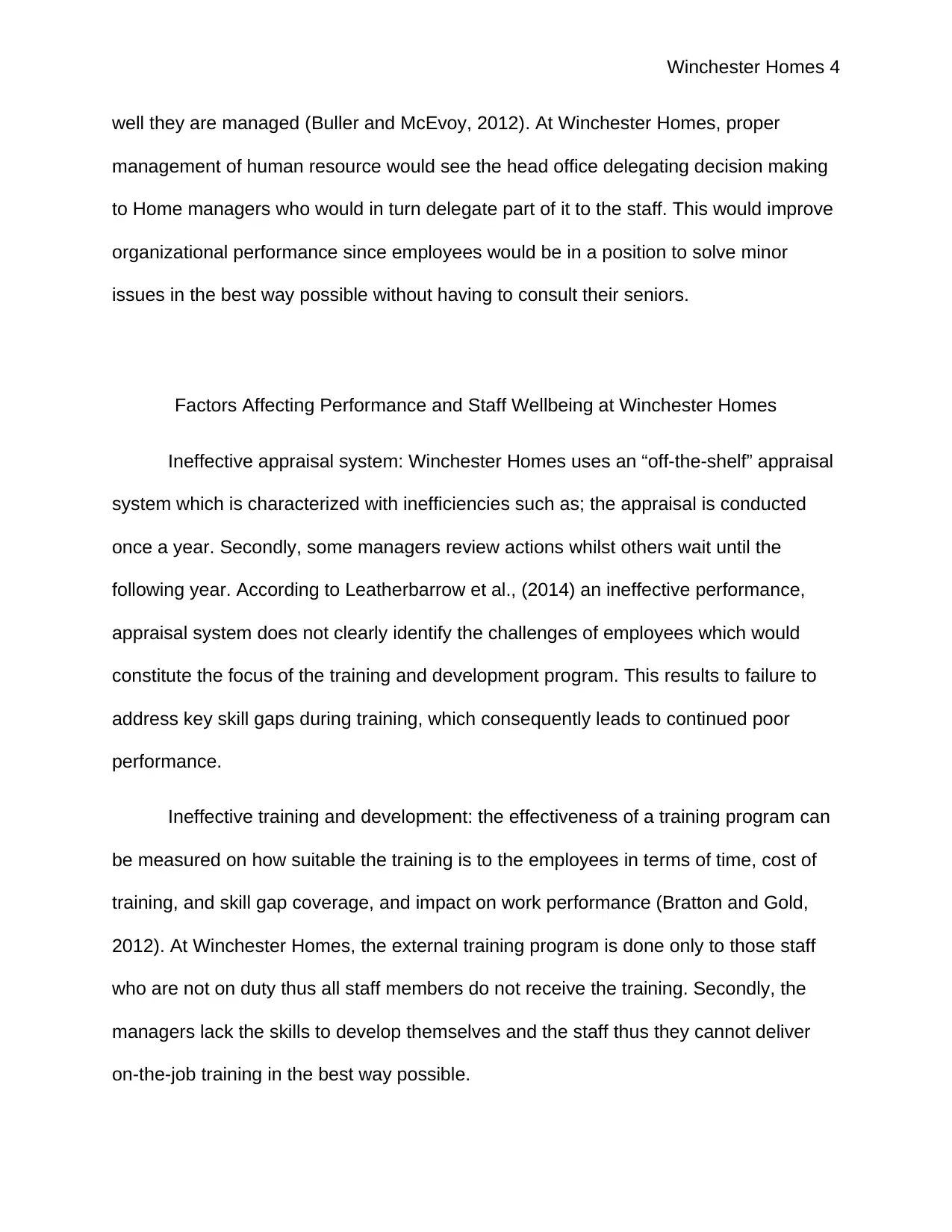
Winchester Homes 4
well they are managed (Buller and McEvoy, 2012). At Winchester Homes, proper
management of human resource would see the head office delegating decision making
to Home managers who would in turn delegate part of it to the staff. This would improve
organizational performance since employees would be in a position to solve minor
issues in the best way possible without having to consult their seniors.
Factors Affecting Performance and Staff Wellbeing at Winchester Homes
Ineffective appraisal system: Winchester Homes uses an “off-the-shelf” appraisal
system which is characterized with inefficiencies such as; the appraisal is conducted
once a year. Secondly, some managers review actions whilst others wait until the
following year. According to Leatherbarrow et al., (2014) an ineffective performance,
appraisal system does not clearly identify the challenges of employees which would
constitute the focus of the training and development program. This results to failure to
address key skill gaps during training, which consequently leads to continued poor
performance.
Ineffective training and development: the effectiveness of a training program can
be measured on how suitable the training is to the employees in terms of time, cost of
training, and skill gap coverage, and impact on work performance (Bratton and Gold,
2012). At Winchester Homes, the external training program is done only to those staff
who are not on duty thus all staff members do not receive the training. Secondly, the
managers lack the skills to develop themselves and the staff thus they cannot deliver
on-the-job training in the best way possible.
well they are managed (Buller and McEvoy, 2012). At Winchester Homes, proper
management of human resource would see the head office delegating decision making
to Home managers who would in turn delegate part of it to the staff. This would improve
organizational performance since employees would be in a position to solve minor
issues in the best way possible without having to consult their seniors.
Factors Affecting Performance and Staff Wellbeing at Winchester Homes
Ineffective appraisal system: Winchester Homes uses an “off-the-shelf” appraisal
system which is characterized with inefficiencies such as; the appraisal is conducted
once a year. Secondly, some managers review actions whilst others wait until the
following year. According to Leatherbarrow et al., (2014) an ineffective performance,
appraisal system does not clearly identify the challenges of employees which would
constitute the focus of the training and development program. This results to failure to
address key skill gaps during training, which consequently leads to continued poor
performance.
Ineffective training and development: the effectiveness of a training program can
be measured on how suitable the training is to the employees in terms of time, cost of
training, and skill gap coverage, and impact on work performance (Bratton and Gold,
2012). At Winchester Homes, the external training program is done only to those staff
who are not on duty thus all staff members do not receive the training. Secondly, the
managers lack the skills to develop themselves and the staff thus they cannot deliver
on-the-job training in the best way possible.
Paraphrase This Document
Need a fresh take? Get an instant paraphrase of this document with our AI Paraphraser
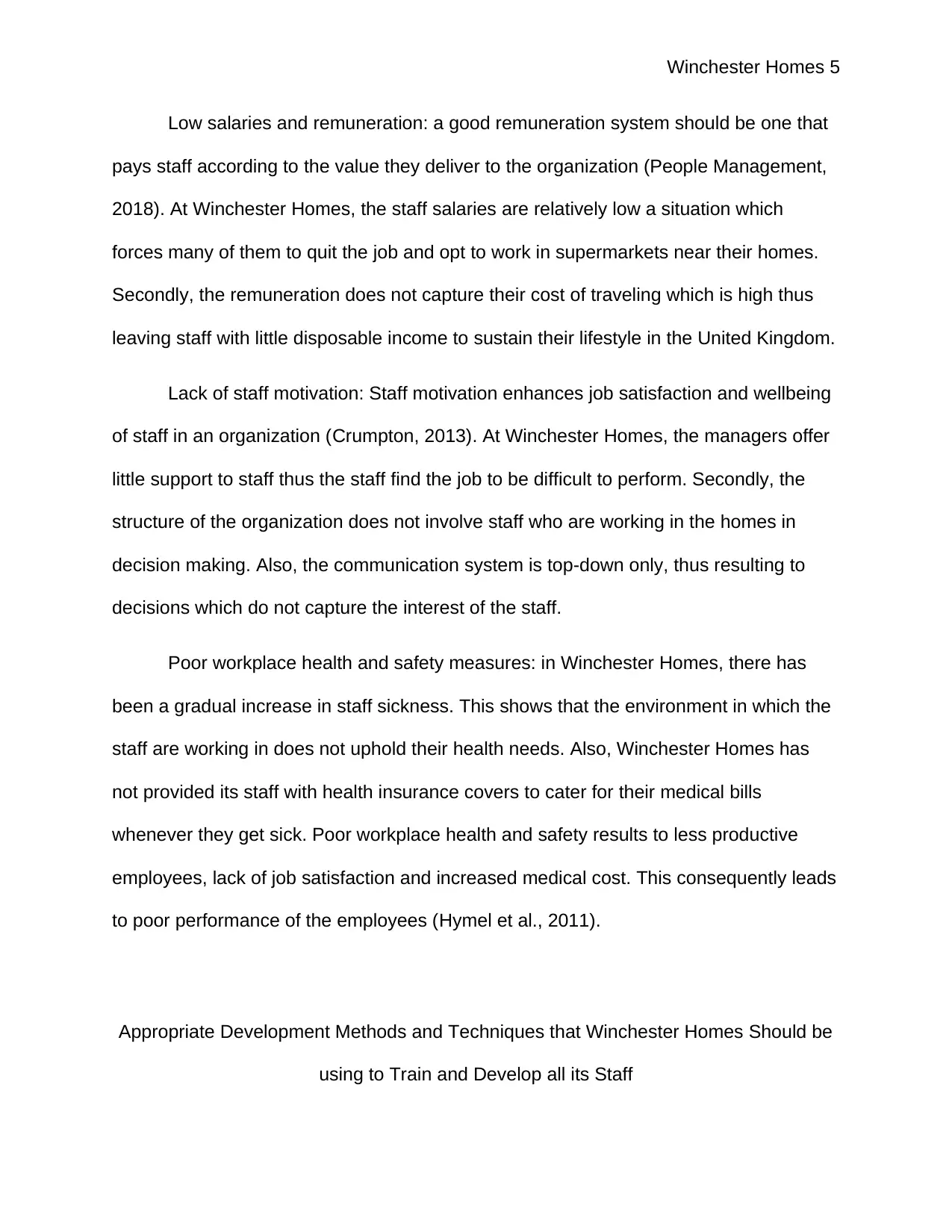
Winchester Homes 5
Low salaries and remuneration: a good remuneration system should be one that
pays staff according to the value they deliver to the organization (People Management,
2018). At Winchester Homes, the staff salaries are relatively low a situation which
forces many of them to quit the job and opt to work in supermarkets near their homes.
Secondly, the remuneration does not capture their cost of traveling which is high thus
leaving staff with little disposable income to sustain their lifestyle in the United Kingdom.
Lack of staff motivation: Staff motivation enhances job satisfaction and wellbeing
of staff in an organization (Crumpton, 2013). At Winchester Homes, the managers offer
little support to staff thus the staff find the job to be difficult to perform. Secondly, the
structure of the organization does not involve staff who are working in the homes in
decision making. Also, the communication system is top-down only, thus resulting to
decisions which do not capture the interest of the staff.
Poor workplace health and safety measures: in Winchester Homes, there has
been a gradual increase in staff sickness. This shows that the environment in which the
staff are working in does not uphold their health needs. Also, Winchester Homes has
not provided its staff with health insurance covers to cater for their medical bills
whenever they get sick. Poor workplace health and safety results to less productive
employees, lack of job satisfaction and increased medical cost. This consequently leads
to poor performance of the employees (Hymel et al., 2011).
Appropriate Development Methods and Techniques that Winchester Homes Should be
using to Train and Develop all its Staff
Low salaries and remuneration: a good remuneration system should be one that
pays staff according to the value they deliver to the organization (People Management,
2018). At Winchester Homes, the staff salaries are relatively low a situation which
forces many of them to quit the job and opt to work in supermarkets near their homes.
Secondly, the remuneration does not capture their cost of traveling which is high thus
leaving staff with little disposable income to sustain their lifestyle in the United Kingdom.
Lack of staff motivation: Staff motivation enhances job satisfaction and wellbeing
of staff in an organization (Crumpton, 2013). At Winchester Homes, the managers offer
little support to staff thus the staff find the job to be difficult to perform. Secondly, the
structure of the organization does not involve staff who are working in the homes in
decision making. Also, the communication system is top-down only, thus resulting to
decisions which do not capture the interest of the staff.
Poor workplace health and safety measures: in Winchester Homes, there has
been a gradual increase in staff sickness. This shows that the environment in which the
staff are working in does not uphold their health needs. Also, Winchester Homes has
not provided its staff with health insurance covers to cater for their medical bills
whenever they get sick. Poor workplace health and safety results to less productive
employees, lack of job satisfaction and increased medical cost. This consequently leads
to poor performance of the employees (Hymel et al., 2011).
Appropriate Development Methods and Techniques that Winchester Homes Should be
using to Train and Develop all its Staff
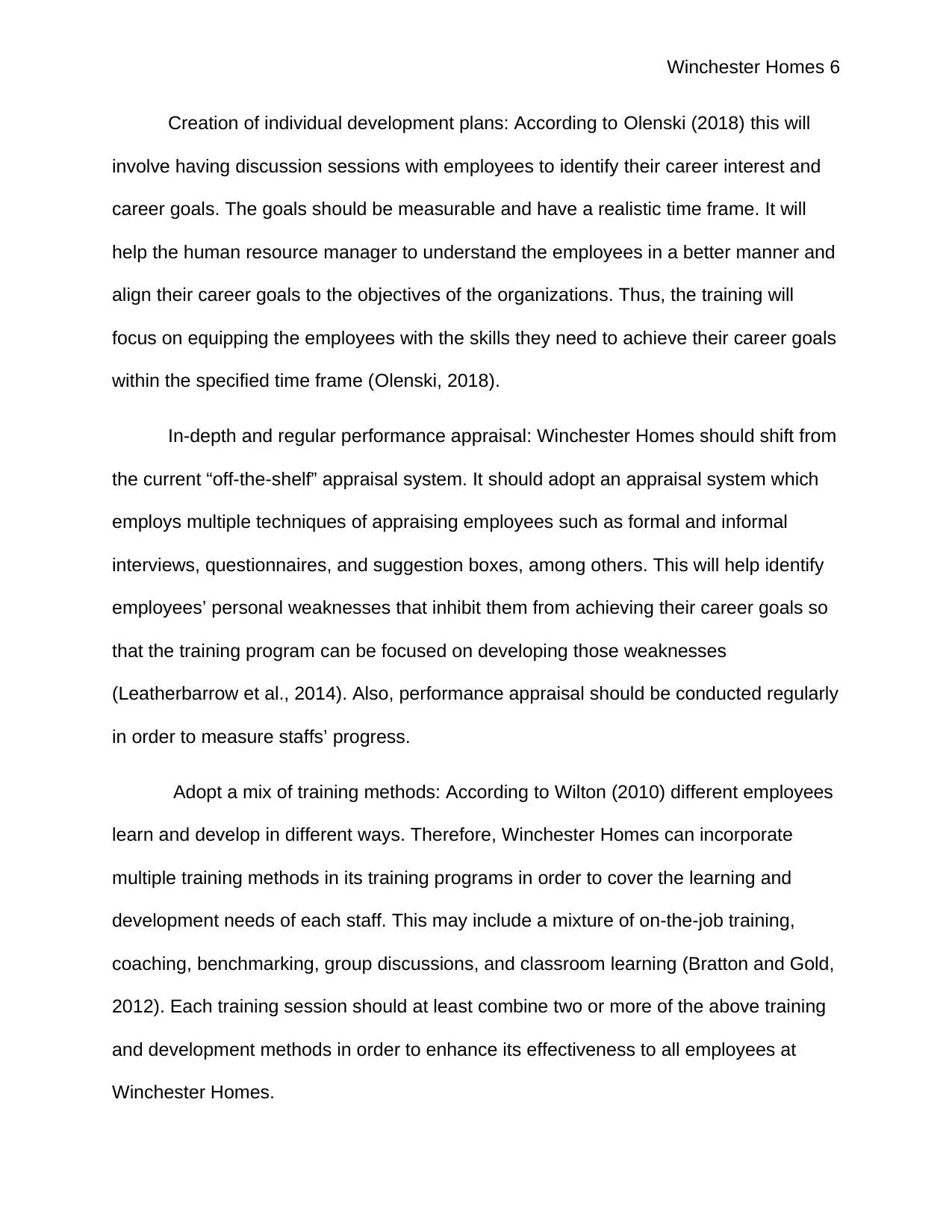
Winchester Homes 6
Creation of individual development plans: According to Olenski (2018) this will
involve having discussion sessions with employees to identify their career interest and
career goals. The goals should be measurable and have a realistic time frame. It will
help the human resource manager to understand the employees in a better manner and
align their career goals to the objectives of the organizations. Thus, the training will
focus on equipping the employees with the skills they need to achieve their career goals
within the specified time frame (Olenski, 2018).
In-depth and regular performance appraisal: Winchester Homes should shift from
the current “off-the-shelf” appraisal system. It should adopt an appraisal system which
employs multiple techniques of appraising employees such as formal and informal
interviews, questionnaires, and suggestion boxes, among others. This will help identify
employees’ personal weaknesses that inhibit them from achieving their career goals so
that the training program can be focused on developing those weaknesses
(Leatherbarrow et al., 2014). Also, performance appraisal should be conducted regularly
in order to measure staffs’ progress.
Adopt a mix of training methods: According to Wilton (2010) different employees
learn and develop in different ways. Therefore, Winchester Homes can incorporate
multiple training methods in its training programs in order to cover the learning and
development needs of each staff. This may include a mixture of on-the-job training,
coaching, benchmarking, group discussions, and classroom learning (Bratton and Gold,
2012). Each training session should at least combine two or more of the above training
and development methods in order to enhance its effectiveness to all employees at
Winchester Homes.
Creation of individual development plans: According to Olenski (2018) this will
involve having discussion sessions with employees to identify their career interest and
career goals. The goals should be measurable and have a realistic time frame. It will
help the human resource manager to understand the employees in a better manner and
align their career goals to the objectives of the organizations. Thus, the training will
focus on equipping the employees with the skills they need to achieve their career goals
within the specified time frame (Olenski, 2018).
In-depth and regular performance appraisal: Winchester Homes should shift from
the current “off-the-shelf” appraisal system. It should adopt an appraisal system which
employs multiple techniques of appraising employees such as formal and informal
interviews, questionnaires, and suggestion boxes, among others. This will help identify
employees’ personal weaknesses that inhibit them from achieving their career goals so
that the training program can be focused on developing those weaknesses
(Leatherbarrow et al., 2014). Also, performance appraisal should be conducted regularly
in order to measure staffs’ progress.
Adopt a mix of training methods: According to Wilton (2010) different employees
learn and develop in different ways. Therefore, Winchester Homes can incorporate
multiple training methods in its training programs in order to cover the learning and
development needs of each staff. This may include a mixture of on-the-job training,
coaching, benchmarking, group discussions, and classroom learning (Bratton and Gold,
2012). Each training session should at least combine two or more of the above training
and development methods in order to enhance its effectiveness to all employees at
Winchester Homes.
⊘ This is a preview!⊘
Do you want full access?
Subscribe today to unlock all pages.

Trusted by 1+ million students worldwide
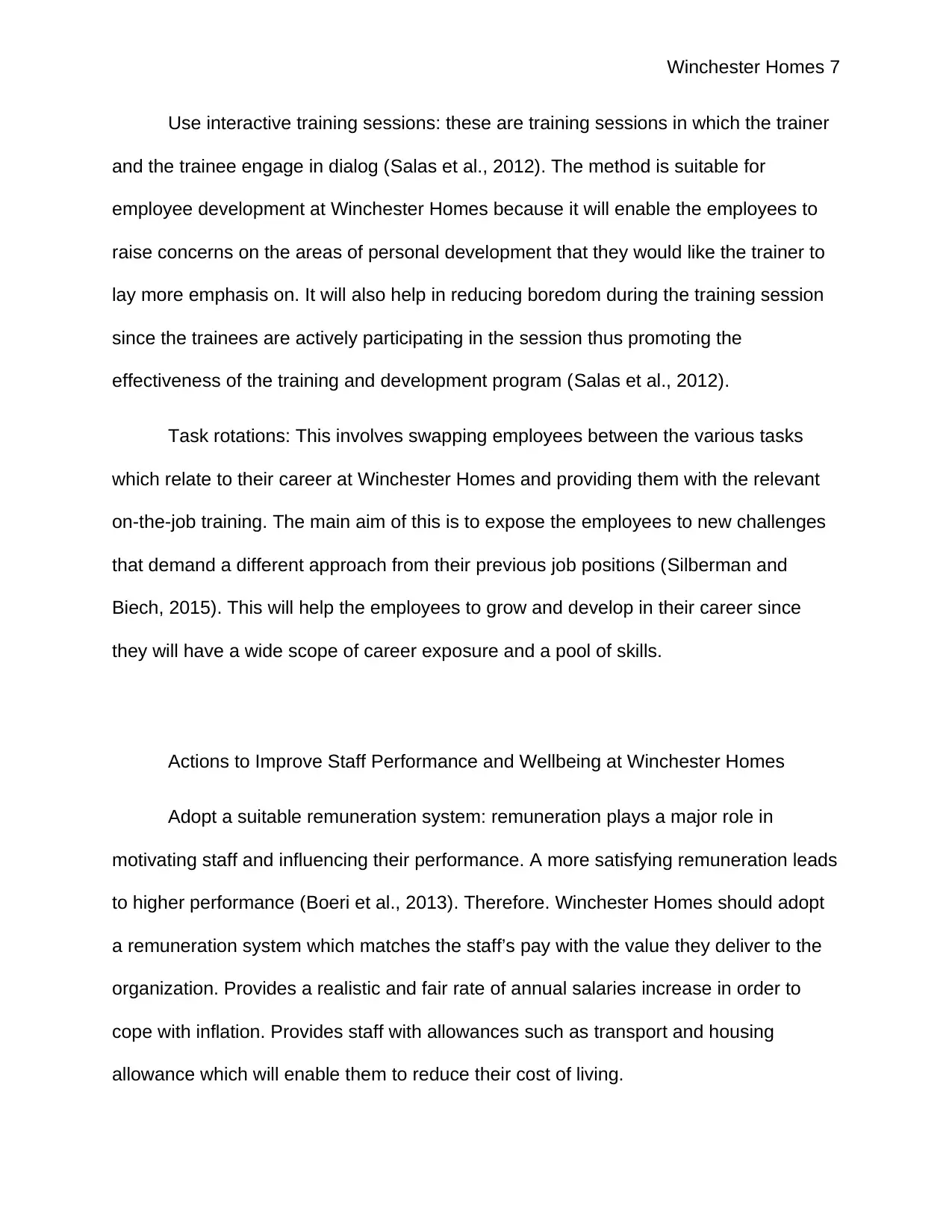
Winchester Homes 7
Use interactive training sessions: these are training sessions in which the trainer
and the trainee engage in dialog (Salas et al., 2012). The method is suitable for
employee development at Winchester Homes because it will enable the employees to
raise concerns on the areas of personal development that they would like the trainer to
lay more emphasis on. It will also help in reducing boredom during the training session
since the trainees are actively participating in the session thus promoting the
effectiveness of the training and development program (Salas et al., 2012).
Task rotations: This involves swapping employees between the various tasks
which relate to their career at Winchester Homes and providing them with the relevant
on-the-job training. The main aim of this is to expose the employees to new challenges
that demand a different approach from their previous job positions (Silberman and
Biech, 2015). This will help the employees to grow and develop in their career since
they will have a wide scope of career exposure and a pool of skills.
Actions to Improve Staff Performance and Wellbeing at Winchester Homes
Adopt a suitable remuneration system: remuneration plays a major role in
motivating staff and influencing their performance. A more satisfying remuneration leads
to higher performance (Boeri et al., 2013). Therefore. Winchester Homes should adopt
a remuneration system which matches the staff’s pay with the value they deliver to the
organization. Provides a realistic and fair rate of annual salaries increase in order to
cope with inflation. Provides staff with allowances such as transport and housing
allowance which will enable them to reduce their cost of living.
Use interactive training sessions: these are training sessions in which the trainer
and the trainee engage in dialog (Salas et al., 2012). The method is suitable for
employee development at Winchester Homes because it will enable the employees to
raise concerns on the areas of personal development that they would like the trainer to
lay more emphasis on. It will also help in reducing boredom during the training session
since the trainees are actively participating in the session thus promoting the
effectiveness of the training and development program (Salas et al., 2012).
Task rotations: This involves swapping employees between the various tasks
which relate to their career at Winchester Homes and providing them with the relevant
on-the-job training. The main aim of this is to expose the employees to new challenges
that demand a different approach from their previous job positions (Silberman and
Biech, 2015). This will help the employees to grow and develop in their career since
they will have a wide scope of career exposure and a pool of skills.
Actions to Improve Staff Performance and Wellbeing at Winchester Homes
Adopt a suitable remuneration system: remuneration plays a major role in
motivating staff and influencing their performance. A more satisfying remuneration leads
to higher performance (Boeri et al., 2013). Therefore. Winchester Homes should adopt
a remuneration system which matches the staff’s pay with the value they deliver to the
organization. Provides a realistic and fair rate of annual salaries increase in order to
cope with inflation. Provides staff with allowances such as transport and housing
allowance which will enable them to reduce their cost of living.
Paraphrase This Document
Need a fresh take? Get an instant paraphrase of this document with our AI Paraphraser
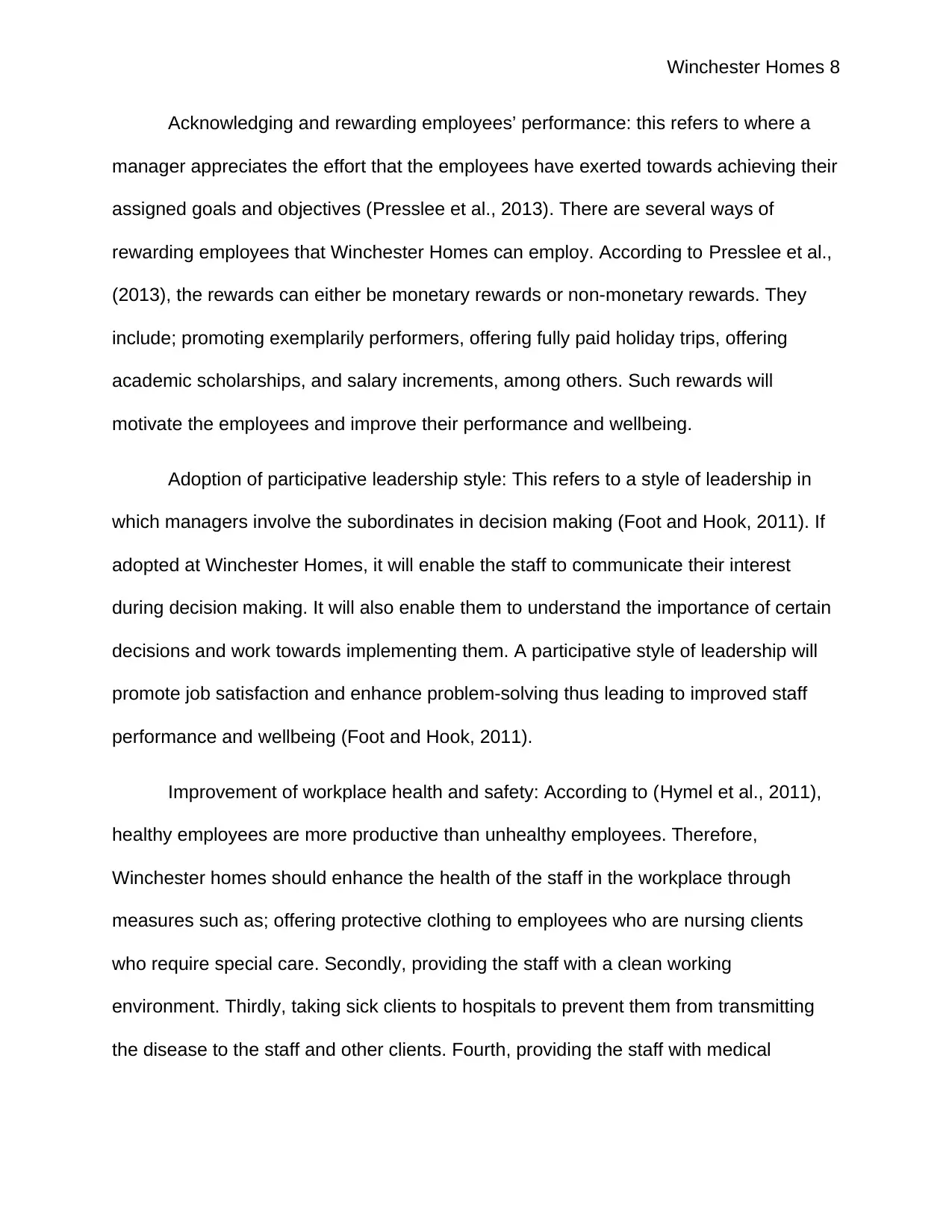
Winchester Homes 8
Acknowledging and rewarding employees’ performance: this refers to where a
manager appreciates the effort that the employees have exerted towards achieving their
assigned goals and objectives (Presslee et al., 2013). There are several ways of
rewarding employees that Winchester Homes can employ. According to Presslee et al.,
(2013), the rewards can either be monetary rewards or non-monetary rewards. They
include; promoting exemplarily performers, offering fully paid holiday trips, offering
academic scholarships, and salary increments, among others. Such rewards will
motivate the employees and improve their performance and wellbeing.
Adoption of participative leadership style: This refers to a style of leadership in
which managers involve the subordinates in decision making (Foot and Hook, 2011). If
adopted at Winchester Homes, it will enable the staff to communicate their interest
during decision making. It will also enable them to understand the importance of certain
decisions and work towards implementing them. A participative style of leadership will
promote job satisfaction and enhance problem-solving thus leading to improved staff
performance and wellbeing (Foot and Hook, 2011).
Improvement of workplace health and safety: According to (Hymel et al., 2011),
healthy employees are more productive than unhealthy employees. Therefore,
Winchester homes should enhance the health of the staff in the workplace through
measures such as; offering protective clothing to employees who are nursing clients
who require special care. Secondly, providing the staff with a clean working
environment. Thirdly, taking sick clients to hospitals to prevent them from transmitting
the disease to the staff and other clients. Fourth, providing the staff with medical
Acknowledging and rewarding employees’ performance: this refers to where a
manager appreciates the effort that the employees have exerted towards achieving their
assigned goals and objectives (Presslee et al., 2013). There are several ways of
rewarding employees that Winchester Homes can employ. According to Presslee et al.,
(2013), the rewards can either be monetary rewards or non-monetary rewards. They
include; promoting exemplarily performers, offering fully paid holiday trips, offering
academic scholarships, and salary increments, among others. Such rewards will
motivate the employees and improve their performance and wellbeing.
Adoption of participative leadership style: This refers to a style of leadership in
which managers involve the subordinates in decision making (Foot and Hook, 2011). If
adopted at Winchester Homes, it will enable the staff to communicate their interest
during decision making. It will also enable them to understand the importance of certain
decisions and work towards implementing them. A participative style of leadership will
promote job satisfaction and enhance problem-solving thus leading to improved staff
performance and wellbeing (Foot and Hook, 2011).
Improvement of workplace health and safety: According to (Hymel et al., 2011),
healthy employees are more productive than unhealthy employees. Therefore,
Winchester homes should enhance the health of the staff in the workplace through
measures such as; offering protective clothing to employees who are nursing clients
who require special care. Secondly, providing the staff with a clean working
environment. Thirdly, taking sick clients to hospitals to prevent them from transmitting
the disease to the staff and other clients. Fourth, providing the staff with medical
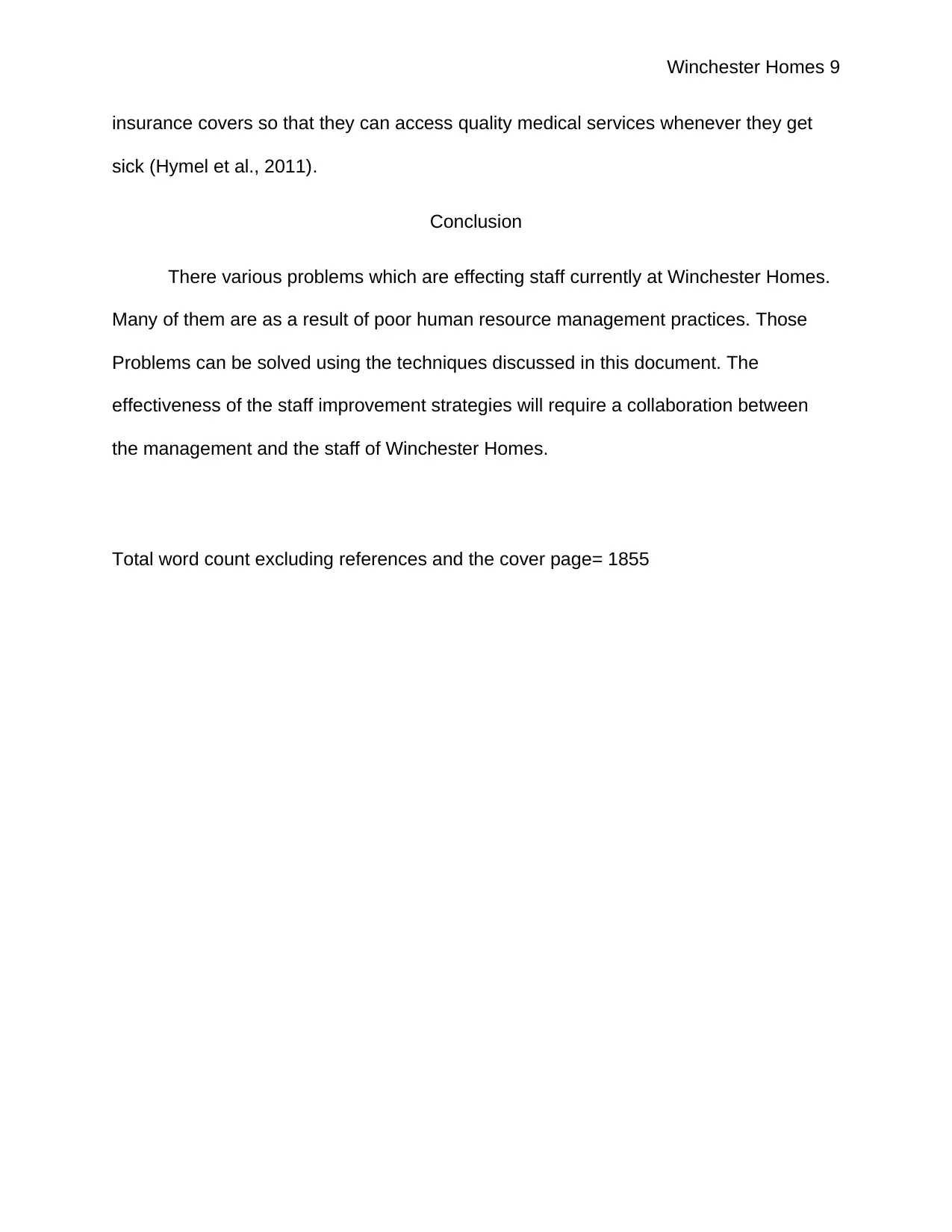
Winchester Homes 9
insurance covers so that they can access quality medical services whenever they get
sick (Hymel et al., 2011).
Conclusion
There various problems which are effecting staff currently at Winchester Homes.
Many of them are as a result of poor human resource management practices. Those
Problems can be solved using the techniques discussed in this document. The
effectiveness of the staff improvement strategies will require a collaboration between
the management and the staff of Winchester Homes.
Total word count excluding references and the cover page= 1855
insurance covers so that they can access quality medical services whenever they get
sick (Hymel et al., 2011).
Conclusion
There various problems which are effecting staff currently at Winchester Homes.
Many of them are as a result of poor human resource management practices. Those
Problems can be solved using the techniques discussed in this document. The
effectiveness of the staff improvement strategies will require a collaboration between
the management and the staff of Winchester Homes.
Total word count excluding references and the cover page= 1855
⊘ This is a preview!⊘
Do you want full access?
Subscribe today to unlock all pages.

Trusted by 1+ million students worldwide
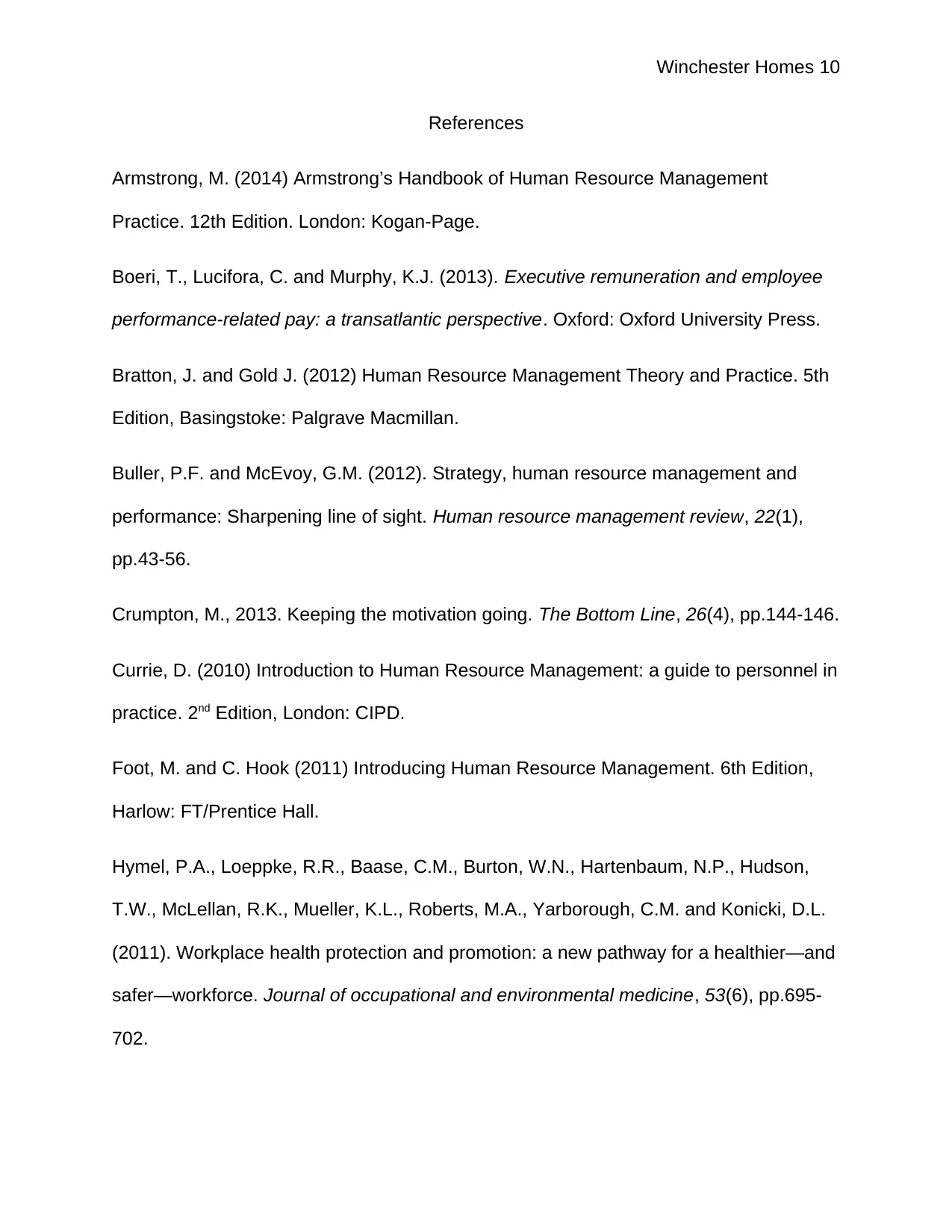
Winchester Homes 10
References
Armstrong, M. (2014) Armstrong’s Handbook of Human Resource Management
Practice. 12th Edition. London: Kogan-Page.
Boeri, T., Lucifora, C. and Murphy, K.J. (2013). Executive remuneration and employee
performance-related pay: a transatlantic perspective. Oxford: Oxford University Press.
Bratton, J. and Gold J. (2012) Human Resource Management Theory and Practice. 5th
Edition, Basingstoke: Palgrave Macmillan.
Buller, P.F. and McEvoy, G.M. (2012). Strategy, human resource management and
performance: Sharpening line of sight. Human resource management review, 22(1),
pp.43-56.
Crumpton, M., 2013. Keeping the motivation going. The Bottom Line, 26(4), pp.144-146.
Currie, D. (2010) Introduction to Human Resource Management: a guide to personnel in
practice. 2nd Edition, London: CIPD.
Foot, M. and C. Hook (2011) Introducing Human Resource Management. 6th Edition,
Harlow: FT/Prentice Hall.
Hymel, P.A., Loeppke, R.R., Baase, C.M., Burton, W.N., Hartenbaum, N.P., Hudson,
T.W., McLellan, R.K., Mueller, K.L., Roberts, M.A., Yarborough, C.M. and Konicki, D.L.
(2011). Workplace health protection and promotion: a new pathway for a healthier—and
safer—workforce. Journal of occupational and environmental medicine, 53(6), pp.695-
702.
References
Armstrong, M. (2014) Armstrong’s Handbook of Human Resource Management
Practice. 12th Edition. London: Kogan-Page.
Boeri, T., Lucifora, C. and Murphy, K.J. (2013). Executive remuneration and employee
performance-related pay: a transatlantic perspective. Oxford: Oxford University Press.
Bratton, J. and Gold J. (2012) Human Resource Management Theory and Practice. 5th
Edition, Basingstoke: Palgrave Macmillan.
Buller, P.F. and McEvoy, G.M. (2012). Strategy, human resource management and
performance: Sharpening line of sight. Human resource management review, 22(1),
pp.43-56.
Crumpton, M., 2013. Keeping the motivation going. The Bottom Line, 26(4), pp.144-146.
Currie, D. (2010) Introduction to Human Resource Management: a guide to personnel in
practice. 2nd Edition, London: CIPD.
Foot, M. and C. Hook (2011) Introducing Human Resource Management. 6th Edition,
Harlow: FT/Prentice Hall.
Hymel, P.A., Loeppke, R.R., Baase, C.M., Burton, W.N., Hartenbaum, N.P., Hudson,
T.W., McLellan, R.K., Mueller, K.L., Roberts, M.A., Yarborough, C.M. and Konicki, D.L.
(2011). Workplace health protection and promotion: a new pathway for a healthier—and
safer—workforce. Journal of occupational and environmental medicine, 53(6), pp.695-
702.
Paraphrase This Document
Need a fresh take? Get an instant paraphrase of this document with our AI Paraphraser
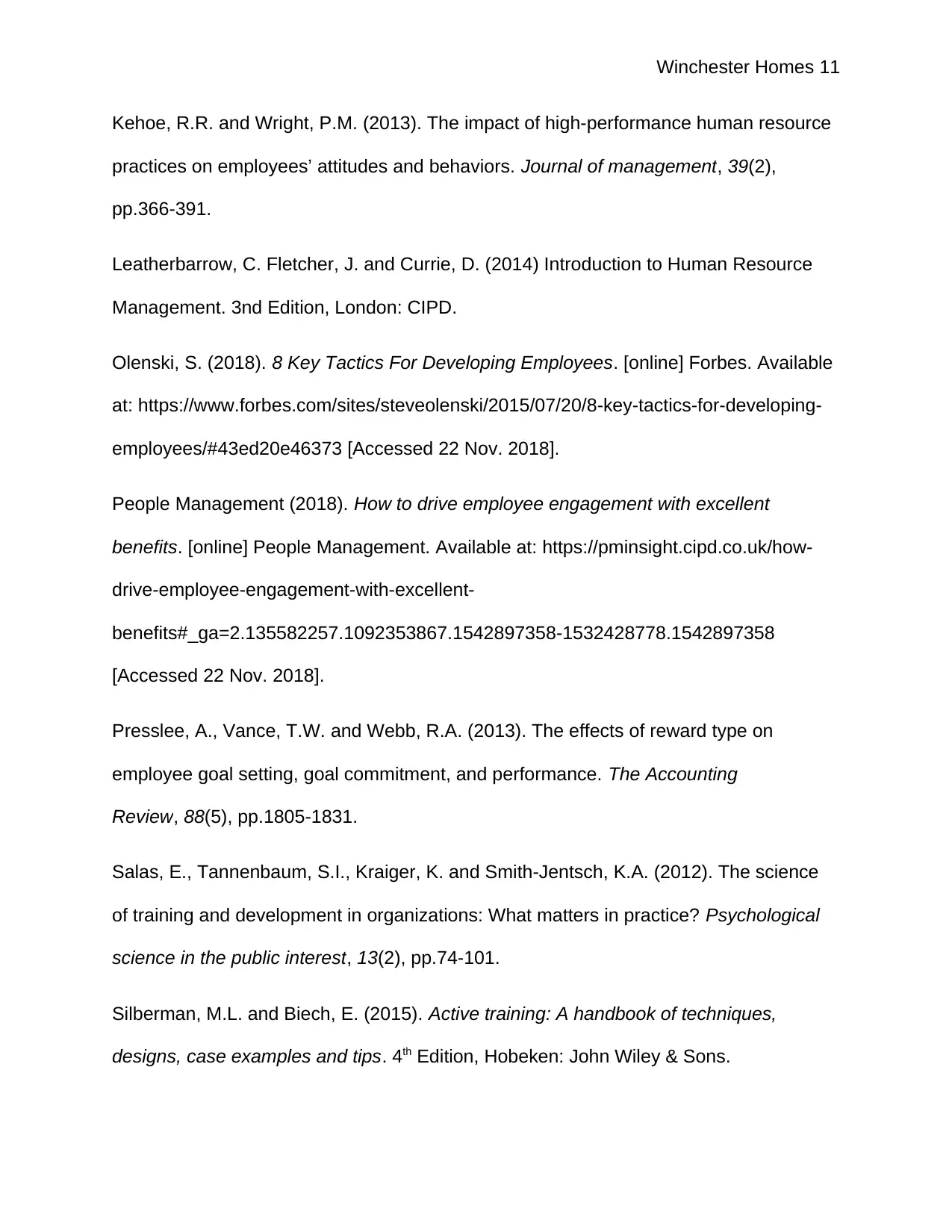
Winchester Homes 11
Kehoe, R.R. and Wright, P.M. (2013). The impact of high-performance human resource
practices on employees’ attitudes and behaviors. Journal of management, 39(2),
pp.366-391.
Leatherbarrow, C. Fletcher, J. and Currie, D. (2014) Introduction to Human Resource
Management. 3nd Edition, London: CIPD.
Olenski, S. (2018). 8 Key Tactics For Developing Employees. [online] Forbes. Available
at: https://www.forbes.com/sites/steveolenski/2015/07/20/8-key-tactics-for-developing-
employees/#43ed20e46373 [Accessed 22 Nov. 2018].
People Management (2018). How to drive employee engagement with excellent
benefits. [online] People Management. Available at: https://pminsight.cipd.co.uk/how-
drive-employee-engagement-with-excellent-
benefits#_ga=2.135582257.1092353867.1542897358-1532428778.1542897358
[Accessed 22 Nov. 2018].
Presslee, A., Vance, T.W. and Webb, R.A. (2013). The effects of reward type on
employee goal setting, goal commitment, and performance. The Accounting
Review, 88(5), pp.1805-1831.
Salas, E., Tannenbaum, S.I., Kraiger, K. and Smith-Jentsch, K.A. (2012). The science
of training and development in organizations: What matters in practice? Psychological
science in the public interest, 13(2), pp.74-101.
Silberman, M.L. and Biech, E. (2015). Active training: A handbook of techniques,
designs, case examples and tips. 4th Edition, Hobeken: John Wiley & Sons.
Kehoe, R.R. and Wright, P.M. (2013). The impact of high-performance human resource
practices on employees’ attitudes and behaviors. Journal of management, 39(2),
pp.366-391.
Leatherbarrow, C. Fletcher, J. and Currie, D. (2014) Introduction to Human Resource
Management. 3nd Edition, London: CIPD.
Olenski, S. (2018). 8 Key Tactics For Developing Employees. [online] Forbes. Available
at: https://www.forbes.com/sites/steveolenski/2015/07/20/8-key-tactics-for-developing-
employees/#43ed20e46373 [Accessed 22 Nov. 2018].
People Management (2018). How to drive employee engagement with excellent
benefits. [online] People Management. Available at: https://pminsight.cipd.co.uk/how-
drive-employee-engagement-with-excellent-
benefits#_ga=2.135582257.1092353867.1542897358-1532428778.1542897358
[Accessed 22 Nov. 2018].
Presslee, A., Vance, T.W. and Webb, R.A. (2013). The effects of reward type on
employee goal setting, goal commitment, and performance. The Accounting
Review, 88(5), pp.1805-1831.
Salas, E., Tannenbaum, S.I., Kraiger, K. and Smith-Jentsch, K.A. (2012). The science
of training and development in organizations: What matters in practice? Psychological
science in the public interest, 13(2), pp.74-101.
Silberman, M.L. and Biech, E. (2015). Active training: A handbook of techniques,
designs, case examples and tips. 4th Edition, Hobeken: John Wiley & Sons.

Winchester Homes 12
Wilton, N. (2010) An Introduction to Human Resource Management. London: Sage
Wilton, N. (2010) An Introduction to Human Resource Management. London: Sage
⊘ This is a preview!⊘
Do you want full access?
Subscribe today to unlock all pages.

Trusted by 1+ million students worldwide
1 out of 12
Related Documents
Your All-in-One AI-Powered Toolkit for Academic Success.
+13062052269
info@desklib.com
Available 24*7 on WhatsApp / Email
![[object Object]](/_next/static/media/star-bottom.7253800d.svg)
Unlock your academic potential
Copyright © 2020–2025 A2Z Services. All Rights Reserved. Developed and managed by ZUCOL.





